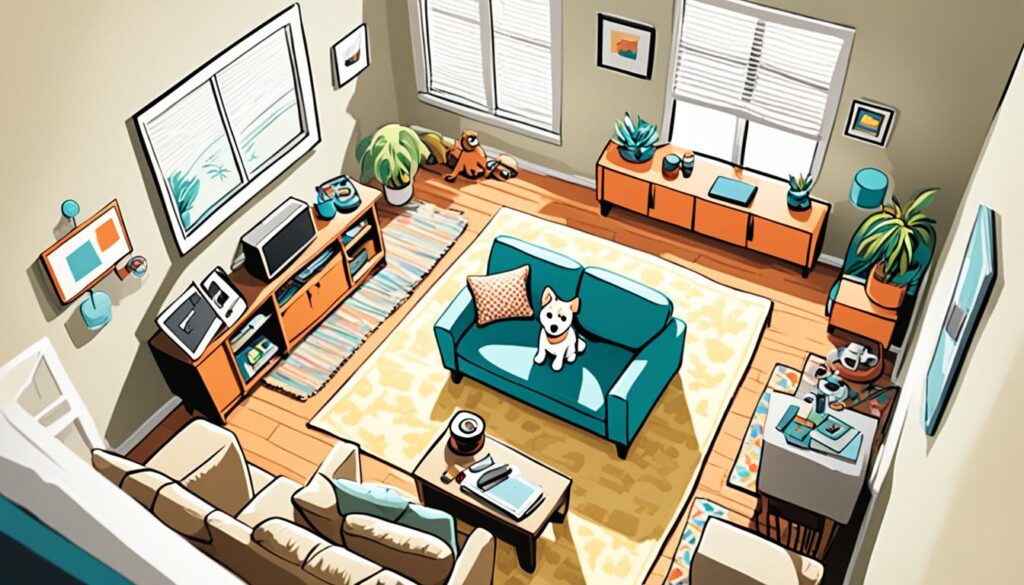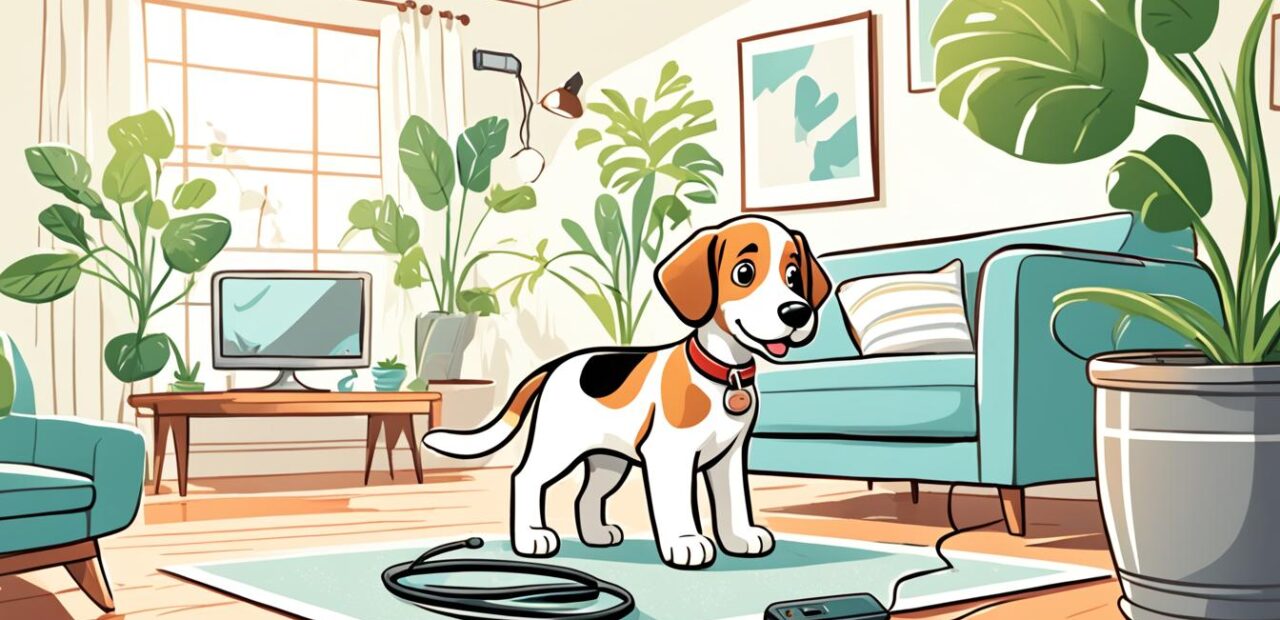Puppy Proofing Your Home: Safety Tips
Did you know that over 5 million puppies are adopted each year in the United States alone? Bringing a new puppy into your home is an exciting time filled with joy and love. However, it is important to prioritize your puppy’s safety and take steps to puppy-proof your home.
Puppy-proofing your home involves creating a safe environment for your furry friend by eliminating potential dangers and hazards. By doing so, you can ensure that your puppy can explore and play freely without the risk of accidents or injuries. Here are some essential safety tips to help you puppy-proof your home and provide a secure space for your new family member:
Indoor Puppy-Proofing Checklist
Puppy-proofing the indoors is crucial to create a safe environment for your furry friend. By taking the necessary precautions, you can prevent potential hazards and ensure your puppy’s safety. Here’s a checklist to help you get started with indoor puppy-proofing:
1. Secure Potential Escape Routes
Inspect your home for any openings or gaps where your puppy could escape, such as loose screens, broken fences, or gaps under doors. Make sure all entry points are secure to prevent your puppy from wandering off.
2. Store Hazardous Chemicals and Medications Safely
Keep all household cleaning products, chemicals, and medications out of your puppy’s reach. Store them in cabinets or lockable containers to prevent accidental ingestion or exposure.
3. Remove Toxic Plants
Some common household plants can be toxic to dogs. Check for any toxic plants in your home and either move them out of reach or replace them with pet-safe alternatives.
4. Secure Wires and Cords
Tuck away or secure loose wires and cords to prevent your puppy from chewing on them, which can cause electric shocks or injuries. Consider using cord covers or cord organizers to keep them out of your puppy’s reach.
5. Keep Small Objects Out of Reach
Remove any small objects, such as coins, beads, or buttons, that can pose a choking hazard for your puppy. Keep them safely stored away or in designated containers.
6. Protect Fragile Items
If you have delicate or valuable items within your puppy’s reach, consider moving them to higher shelves or using baby gates to restrict access to certain areas.
7. Block Access to Dangerous Areas
Identify areas in your home that could be potentially dangerous for your puppy, such as staircases, balconies, or rooms with valuable items. Use baby gates or other barriers to block off these areas.
8. Secure Trash Bins
Make sure your trash bins are securely closed and out of your puppy’s reach. Dispose of potentially harmful items, such as sharp objects, toxic substances, or small choking hazards, properly.
9. Provide Safe Chew Toys
Offer a variety of safe and appropriate chew toys to keep your puppy engaged and prevent them from chewing on household items that could be harmful.
10. Create a Safe and Comfortable Resting Area
Set up a designated resting area for your puppy with a comfortable bed or crate. Make sure the area is free from any hazards and provides a cozy space for your puppy to relax.
By following this indoor puppy-proofing checklist, you can ensure a safe and secure environment for your new furry family member.
Outdoor Puppy-Proofing Checklist
Outdoor spaces can offer exciting adventures for your puppy, but they also come with potential hazards. To ensure your puppy’s safety outdoors, follow this comprehensive checklist:
- Inspect the perimeter: Check for any gaps or holes in your fence or barriers that your puppy could escape through. Repair or reinforce them to prevent any escape attempts.
- Remove toxic plants: Identify and remove any toxic plants or flowers from your yard. Some common examples include lilies, azaleas, and daffodils. Keep in mind that puppies are curious and may chew on plants.
- Secure trash bins: Make sure your trash bins have tight-fitting lids or store them in a secure location. Dispose of potentially harmful items, such as food scraps or sharp objects, properly.
- Check for chemicals: Store chemicals, such as fertilizers, pesticides, and cleaning products, safely out of your puppy’s reach. Keep them in locked cabinets or on high shelves.
- Inspect outdoor structures: Examine any outdoor structures, such as sheds or play equipment, for any sharp edges or loose parts. Fix or remove them to avoid accidents.
- Block access to pools and ponds: If you have a swimming pool or pond in your yard, ensure your puppy cannot access it unsupervised. Use fences, barriers, or pool covers to prevent accidental drowning.
- Secure outdoor electrical outlets: Cover any exposed electrical outlets or wires to prevent your puppy from chewing on them. Use outlet covers or hide wires behind protective casings.
- Provide shade and water: Create shaded areas in your yard where your puppy can retreat from direct sunlight. Ensure there is always fresh and clean water available for your puppy to stay hydrated.
By following this outdoor puppy-proofing checklist, you can ensure a safe and enjoyable environment for your furry friend to explore and play in.
https://www.youtube.com/watch?v=sZEeKbx-TBM
Remember, outdoor activities should always be supervised, especially for young puppies. Keep an eye on them at all times to prevent any potential accidents or mishaps.
Puppy-Proofing Tips for Inside Your Home
Ensuring the safety of your puppy inside your home is essential for their well-being. By taking the time to address potential hazards and secure your space, you can create a safe environment where your furry friend can explore and play without unnecessary risks.
1. Store Hazardous Chemicals Securely
Puppies are curious creatures and may be tempted to explore cabinets and shelves. Ensure that all hazardous chemicals such as cleaning products, pesticides, and medications are stored securely in locked cabinets out of your puppy’s reach. This will help prevent accidental ingestion and potential poisoning.
2. Secure Electrical Cords
Puppies love to chew on things, including electrical cords. Protect your puppy from electrical hazards by securing cords and keeping them out of their reach. Use cord covers or hide cords behind furniture to prevent them from becoming a tempting target.
3. Keep Small Objects Out of Reach
Puppies, especially during their teething phase, may chew on small objects that can pose a choking hazard. Keep items like coins, buttons, jewelry, and small toys safely stored away or placed at a height where your puppy can’t access them.
4. Remove Toxic Plants
Some houseplants can be toxic to dogs if ingested. Research and identify any toxic plants in your home, and either remove them or keep them out of your puppy’s reach. Opt for pet-safe plants as an alternative to beautify your space.
5. Secure Trash Bins
Puppies are notorious for getting into trash bins and making a mess. Use secure lids or keep your trash bins in a cabinet to prevent your puppy from accessing potentially harmful items, such as spoiled food, wrappers, or sharp objects.
6. Install Baby Gates
Baby gates can be an excellent way to limit your puppy’s access to certain areas of your home, such as staircases or rooms with fragile items. Use sturdy gates that your puppy cannot easily knock down or climb over.
7. Watch Out for Dangling Cords and Blinds
Puppies may be tempted to chew on dangling cords or blinds, which can pose a strangulation hazard. Keep cords out of reach or use cord holders to secure them. Additionally, tie up blinds or use cordless alternatives to eliminate this potential danger.
8. Secure Loose Carpets and Rugs
Puppies love to explore and may trip or get tangled in loose carpets and rugs. Secure them with non-slip pads or double-sided tape to prevent accidents and ensure your puppy can move around safely.
9. Provide Safe Chew Toys
Redirect your puppy’s chewing instincts to safe, appropriate chew toys. Offer a variety of toys with different textures and sizes to keep them engaged and entertained, while also preventing them from chewing on furniture or other household items.

By implementing these puppy-proofing tips, you can create a safe and secure environment inside your home for your new furry family member. Remember, each puppy is unique, so take some time to observe and adjust your precautions based on your puppy’s behavior and specific needs.
Conclusion
Ensuring the safety of your puppy is of utmost importance. By following the puppy-proofing tips for your home, both indoors and outdoors, you can create a safe environment for your new furry friend.
Remember, supervision plays a key role in keeping your puppy safe. Always keep an eye on them to prevent any potential hazards. By being proactive and taking these precautions, you can enjoy peace of mind knowing that your puppy is safe and protected in their new home.
In summary, puppy-proofing your home involves eliminating potential dangers and hazards that could harm your puppy. By securing indoor areas, protecting outdoor spaces, and implementing safety measures, you can provide your puppy with a secure environment where they can thrive and grow.
So, take the necessary steps to puppy-proof your home and give your furry friend the best possible start in their new life with you. Your puppy’s safety should always be a top priority.
FAQ
Why is puppy-proofing important when bringing a new puppy home?
Puppy-proofing is crucial to ensure the safety of your new furry friend. It involves eliminating potential hazards and dangers in your home to create a secure environment for your puppy to thrive in.
What should I consider when puppy-proofing indoors?
When puppy-proofing indoors, it is important to consider specific areas and items such as electrical cords, toxic plants, chemicals, small objects that can be swallowed, and secure storage for food and medications.
How can I ensure my puppy’s safety in outdoor spaces?
To ensure your puppy’s safety outdoors, you should check for potential hazards such as poisonous plants, ensure the fencing is secure, remove any toxic substances, and provide appropriate shelter and shade.
Are there any special considerations for puppy-proofing inside the house?
Yes, in addition to general indoor puppy-proofing, you should also consider keeping doors closed to restrict access to certain areas, blocking off staircases, using baby gates to confine your puppy when needed, and securing hazardous areas such as the kitchen.
Why is it important to supervise my puppy at all times?
Supervising your puppy at all times is crucial to prevent accidents and quickly intervene if they encounter any potential hazards. It allows you to ensure their safety and correct any unwanted behaviors.

